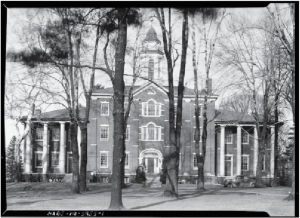The Campus was there for the last Bentley reconstruction
The last major renovation of Bentley Hall, in 1925, was covered at the time by The Campus. While details are scarce, it provides an interesting perspective on the building’s condition at the time.
The two renovations — this year’s and the one nearly a century ago — share many similarities. For example, ensuring the mortar would last another 100 years was a priority, as was modernizing the building. At that time, modernization meant electric lights and indoor plumbing, not geothermal climate control and adding elevators.
A preview article, printed on the front page of the Tuesday, Sept. 23, 1924, Campus, noted that the renovations would add “usefulness and beauty” to “old Bentley.”
“Bentley Hall, the center of Allegheny tradition, is undergoing a course of renovation that will make it, on completion, one of the most up-to-date, yet unique, buildings in the state,” the story, which has no byline, reads. “When finished, it will be a true Colonial type of edifice in every respect, and it will go a long way toward the further beautification of our campus.”
According to the article, the tiled first floor was a part of the renovation, and the green Vermont slate roof was as well. Windows with “smaller panes of glass” were added — perhaps the 1925 renovation was when the windows changed from six over six panes to nine over nine.
Yet, as extensive as these renovations were, construction itself lasted less than one year and the building’s occupants remained.
“Persons using the building will encounter slight inconveniences from time to time during the reconstruction,” the 1924 article reads, “but with proper consideration and cooperation no great difficulty will be experienced.”
The renovations finished in April 1925, according to an April 22, 1925, Campus article, titled “Bentley made attractive.”
“Returning alumni at Commencement time will be surprised and impressed with the improvements which have been made in Bentley Hall during the year,” the article, also unsigned, reads.
In addition to the renovations outlined in the 1924 article, the 1925 article notes several additional improvements: interior woodwork was finished in walnut and white, while exterior woodwork was painted white; windows received new blinds; electric light was provided to all rooms and interior walls were painted cream. Halls and staircases were covered with linoleum, and indoor bathrooms were installed.
The renovations involved external improvements as well, The Campus reported. A wider set of stairs was added to the south side of the building, as was a new sidewalk made of broken flagstone set in concrete, and brick walls were repointed.
“Many other improvements of like nature are planned, and the work will probably continue nearly until the end of the term,” the article reads in part. “It is hoped, however, to have everything completed in time for Commencement.”








